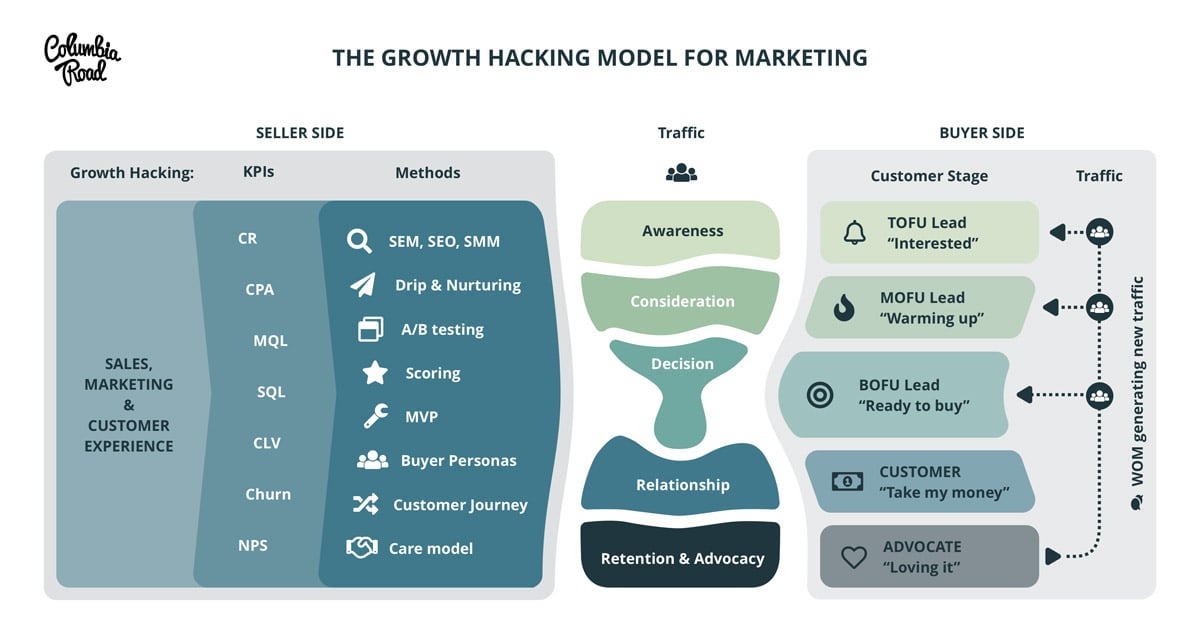The Data Handbook
How to use data to improve your customer journey and get better business outcomes in digital sales. Interviews, use cases, and deep-dives.
Get the bookHow does growth hacking change business logic?
Growth hacking refers to a paradigm shift, wherein old marketing methods and tools make way for new channels and ways of working. In this rather unconventional and new business context, growth can be obtained through novel, experimental means – as aspirational growth marketers and engineers seek to first-handily grow or attain market demand, or traction.

Demand for a product or service can be generated organically (i.e. content marketing, SEO) or through paid advertising (e.g. SEM, social media marketing aka SMM). From an analytics viewpoint, demand translates to marketing qualified leads (MQLs), sales qualified leads (SQLs), and conversions.
Regarding content marketing, the increase in traffic volume depends largely on the extent to which content can be tailored. This content should be produced for particular – segmented or hyper-targeted – clients (aka buyer personas). These ideal customers can be built based on real market data or, regarding a novel offering or startup, be hypotheses of customers whose interest in the offering can be tested with experimental campaigns. Only when relevant, persona-oriented content is in place, can online forms be used to capture lead information, and only then can sellers expect conversions to occur. The key metric to monitor here is conversion rate (CR).
This is the basis on which sellers can, later on, build drip nurturing, lead nurturing, workflows, and scoring programs, as well as seek to grow revenue through up-selling, cross-selling, and customer care models. This can be efficiently accomplished with marketing automation methods.
Optimally, a customer’s use case and stage in the buyer’s journey would be considered throughout the process, and A/B testing would occur to weed out non-optimal audiences. Herein, the client’s pain points and urgency are addressed with custom-designed, funnel-focused top-of-the-funnel (TOFU), middle-of-the-funnel (MOFU), or bottom-of-the-funnel (BOFU) content.
A customer-centric strategy is paramount for growth hacking. As a matter of fact, studies have shown that while the majority (88%) of B2B marketers use custom content marketing, nearly 2/3 don’t know which type of content is effective.
If you'd like to learn more about how to build relevant buyer personas and buyer's journey maps, take a look at these templates:
The self-sustaining funnel of growth
With inbound marketing platforms, such as HubSpot, marketers can collect vital prospect information in stealth mode. Equipped with this data provided by marketers, salespeople can act and engage with the prospect in a meaningful way, and at an appropriate time.
With all the lead and customer data, growth hackers are like magicians performing small “charms and incantations” – micro-campaigns – to the right people at the right time. They can tap into the ever-growing pool of data and design measures to grow the business even further. Hence, growth hacking essentially is just-in-time marketing (JITM).
Using this approach, sellers and marketers of the modern age can avoid pushy and obtrusive cold-selling tactics. Especially, with the introduction of marketing automation tools into growth hacking, the functions of marketing and sales merge into a unified process and become a joint effort. They no longer represent the two ends of a spectrum but, rather, makeup one holistic process with empowered individuals.
Other disciplines will also merge to serve the client in the best possible manner. This process preferably has no endpoint. When each team works together towards a common goal, they can truly grow the customer lifetime value (CLV) and lower the churn rate. Thereby, the typical challenges of cross-functional teams may be bypassed.
The depicted growth funnel lives off of traffic, digests conversions, and produces brand advocates that speak well of the company – and do so willingly of their own accord. The positive word-of-mouth (WOM) or goodwill of these referees, in turn, builds a loop that feeds the funnel with traffic. These leads are likely to be warmer for sales engagement, making the funnel shorter.
Moreover, with these new leads becoming referees, the funnel becomes self-sustaining; the growth cycle becomes a self-reinforcing one. Success can be measured with net promoter score (NPS).
Systems thinking, essentially, forms the very heart of growth hacking. For the seller, this means raising the bar. As more and warmer leads flock in with high hopes, continuous learning and iteration become a necessity.
So what does it all mean?
By relying on digital channels and experimental techniques, growth hackers can be seen as multidisciplinary, digital business designers, who are in search of not only instant gains but also long-term business results.
Growth hacking is not a one-time trick shot but, more importantly, a new, agile, way of working and building the entire business. Growth hackers are key performance indicator (KPI) -focused, tech-savvy wizards with a license to fail by using the minimum viable product (MVP) approach. With this mindset, they seek to bring about more sales and attract more customers.
Growth hacking is a company culture or strategy that seeks to attract and engage with relevant audiences through cost-efficient means for lower cost per action (CPA) as well as improve current systems and/or processes through continuous conversion rate optimisation (CRO). If executed well, growth hacking can bring about competitive advantages.
Delighting the customer and exceeding expectations over and over again is key for successful customer lock-in.
The Data Handbook
How to use data to improve your customer journey and get better business outcomes in digital sales. Interviews, use cases, and deep-dives.
Get the book



